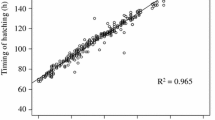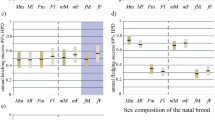Abstract
The blue-footed booby (Sula nebouxii) commonly hatches two eggs 4 days apart; then the senior (first-hatched) chick aggressively dominates the other and sometimes kills it. Two hypotheses explaining the function of the hatching interval were tested by creating broods with synchronous hatching: the facultative brood reduction hypothesis of Lack (1954) and the sibling rivalry reduction hypothesis of Hahn (1981). The results contradicted most predictions of both hypotheses: synchronous broods formed an aggressive hierarchy similarly to asynchronous broods (controls), and subordinate chicks grew poorly (Fig. 1) and died frequently, similarly to junior chicks in control broods. However, compared with synchronous broods, asynchronous broods showed less aggression (Fig. 2), diminished food allocation to subordinate chicks (Fig. 3) and less total food consumption (30% fewer feeds at age 0–10 days). These behavioral comparisons took into account the different ages of chicks in different treatments. The results suggest that natural asynchrony makes brood reduction more efficient and decreases the costs of sibling aggression to parents, in terms of their future survival or fecundity, as proposed by Mock and Ploger (1987). Further, in exaggeratedly asynchronous broods (8-day hatch interval) junior chicks suffered more aggression (Fig. 4) and grew more slowly than junior chicks in control broods. This result supports the hypothesis of optimal hatch asynchrony of Mock and Ploger (1987).
Similar content being viewed by others
References
Amundsen T, Stokland JN (1988) Adaptative significance of asynchronous hatching in the shag: a test of brood reduction hypothesis. J Anim Ecol 57:329–344
Amundsen T, Slagsvold S (1991) Hatching asynchrony: facilitating adaptive or maladaptive brood reduction? Proc Int Ornithol Congr 20:1707–1719
Anderson DJ (1989) Differential responses of boobies and other seabirds in the Galápagos to the 1986–87 El Niño Southern Oscillation event. Mar Ecol Prog Ser 52:209–216
Bancroft GT (1985) The influence of total nest failures and partial nest losses on the evolution of asynchronous hatching. Am Nat 126:495–504
Clark AB, Wilson DS (1981) Avian breeding adaptations: hatching asynchrony, brood reduction, and nest failure. Q Rev Biol 56:253–277
Diaz HF, Kiladis GN (1992) Atmospheric teleconnections associated with the extreme phases of the southern oscillation. In: Diaz HF, Markgraf V (eds) El niño: historical and paleoclimatic aspects of the southern oscillation. Cambridge University Press, Cambridge, pp 7–28
Drummond H, García Chavelas C (1989) Food shortage influences sibling aggression in the blue-footed booby. Anim Behav 37:806–819
Drummond H, Osorno JL (1992) Training siblings to be submissive losers: dominance between booby nestlings. Anim Bebav 44:881–893
Drummond H, Gonzalez E, Osorno JL (1986) Parent-offspring cooperation in the blue-footed booby (Sula nebouxii): social roles in infaticidal brood reduction. Behav Ecol Sociobiol 19:365–372
Drummond H, Osorno JL, Torres R, Garcia Chavelas C, Merchant H (1991) Sexual size dimorphism and sibling competition: implications for avian sex ratios. Am Nat 138:623–641
Fujioka M (1985) Food delivery and sibling competition in experimentally even-aged broods of the cattle egret. Behav Ecol Sociobiol 17:67–74
Gibbons JW (1987) Hatching asynchrony reduces parental investment in the jackdaw. J Anim Ecol 56:403–414
Hahn DC (1981) Asynchronous hatching in the laughing gull: cutting losses and reducing rivalry. Anim Behav 29:441–427
Hamilton WD (1964) The genetical evolution of social behaviour II. J Theor Biol 7:17–52
Haydock J, Ligon JD (1986) Brood reduction in the Chihuahuan raven: an experimental study. Ecology 67:1194–1205
Lack D (1947) The significance of clutch-size. Ibis 89:302–352
Lack D (1954) The natural regulation of animal numbers. Oxford University Press, Oxford
Lack D (1966) Population studies in birds. Clarendon Press, Oxford.
Lack D (1968) Ecological adaptations for breeding in birds. Methuen, London
Lessells CM, Avery MI (1989) Hatching asynchrony in european bee-eaters Merops apiaster. J Anim Ecol 58:815–835
Magrath RD (1989) Hatching asynchrony and reproductive success in the blackbird. Nature 339:536–538
Mock DW (1994) Brood reduction: narrow sense, broad sense. J Avian Biol 25:3–7
Mock DW, Forbes LS (1994) Life-history consequences of avian brood reduction. Auk 111:115–123
Mock DW, Ploger BJ (1987) Parental manipulation of optimal hatch asynchrony in cattle egrets: an experimental study. Anim Behav 35:150–160
Osorno JL (1991) Manipulación experimental del intervalo de eclosión en el bobo de patas azules. MSc. Thesis, Facultad de Ciencias, UNAM, Mexico
Sokal RR, Rohlf FJ (1981) Biometry, 2nd edn. Freeman, New York
Skutch AF (1976) Parent birds and their young. University of Texas Press, Austin
Slagsvold T (1982) Clutch size, nest size and hatching asynchrony in birds: experiments with the fieldfare (Turdus pilaris). Ecology 63:1389–1399
Slagsvold T, Amundsen T, Dale S (1994) Selection by sexual conflict for evenly spaced offspring in blue tits. Nature 370:136–138
Author information
Authors and Affiliations
Additional information
Communicated by F. Trillmich
Rights and permissions
About this article
Cite this article
Osorno, J.L., Drummond, H. The function of hatching asynchrony in the blue-footed booby. Behav Ecol Sociobiol 37, 265–273 (1995). https://doi.org/10.1007/BF00177406
Received:
Accepted:
Issue Date:
DOI: https://doi.org/10.1007/BF00177406




